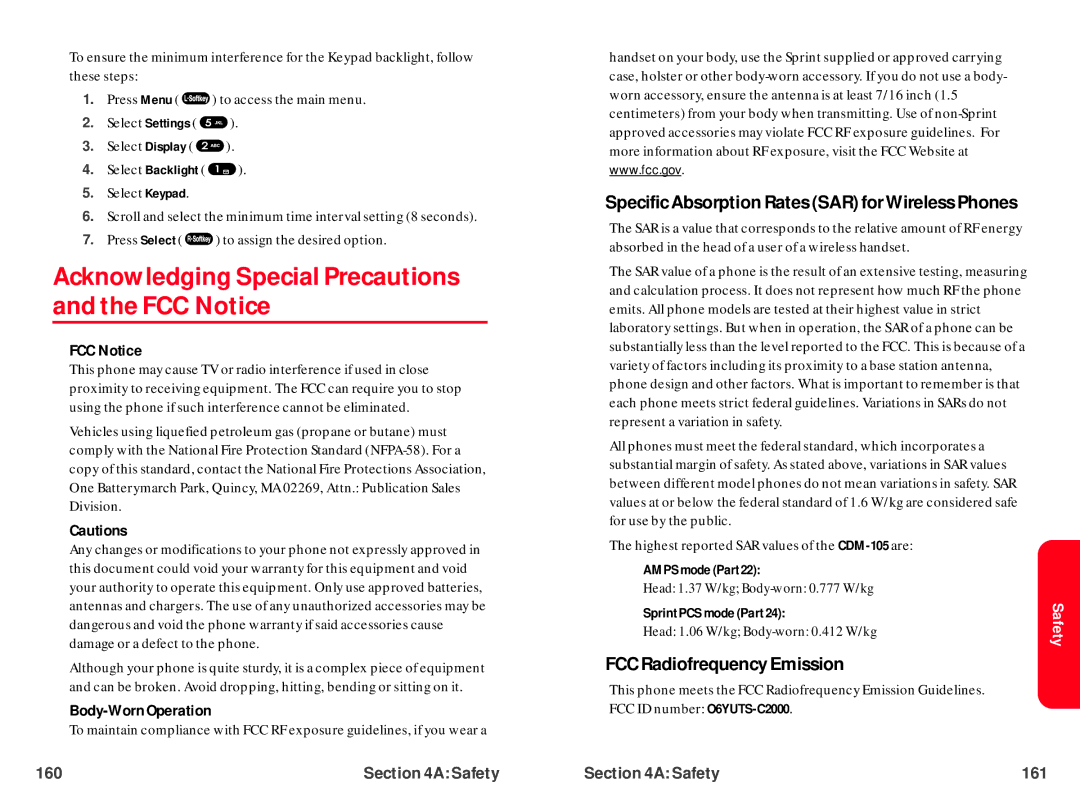
To ensure the minimum interference for the Keypad backlight, follow these steps:
1.Press Menu ( ![]() ) to access the main menu.
) to access the main menu.
2.Select Settings ( ![]() ).
).
3.Select Display ( ![]() ).
).
4.Select Backlight ( ![]() ).
).
5.Select Keypad.
6.Scroll and select the minimum time interval setting (8 seconds).
7.Press Select ( ![]() ) to assign the desired option.
) to assign the desired option.
Acknowledging Special Precautions and the FCC Notice
FCC Notice
This phone may cause TV or radio interference if used in close proximity to receiving equipment. The FCC can require you to stop using the phone if such interference cannot be eliminated.
Vehicles using liquefied petroleum gas (propane or butane) must comply with the National Fire Protection Standard
Cautions
Any changes or modifications to your phone not expressly approved in this document could void your warranty for this equipment and void your authority to operate this equipment. Only use approved batteries, antennas and chargers. The use of any unauthorized accessories may be dangerous and void the phone warranty if said accessories cause damage or a defect to the phone.
Although your phone is quite sturdy, it is a complex piece of equipment and can be broken. Avoid dropping, hitting, bending or sitting on it.
Body-Worn Operation
To maintain compliance with FCC RF exposure guidelines, if you wear a
handset on your body, use the Sprint supplied or approved carrying case, holster or other
www.fcc.gov.
Specific Absorption Rates (SAR) forWireless Phones
The SAR is a value that corresponds to the relative amount of RF energy absorbed in the head of a user of a wireless handset.
The SAR value of a phone is the result of an extensive testing, measuring and calculation process. It does not represent how much RF the phone emits. All phone models are tested at their highest value in strict laboratory settings. But when in operation, the SAR of a phone can be substantially less than the level reported to the FCC. This is because of a variety of factors including its proximity to a base station antenna, phone design and other factors. What is important to remember is that each phone meets strict federal guidelines. Variations in SARs do not represent a variation in safety.
All phones must meet the federal standard, which incorporates a substantial margin of safety. As stated above, variations in SAR values between different model phones do not mean variations in safety. SAR values at or below the federal standard of 1.6 W/kg are considered safe for use by the public.
The highest reported SAR values of the
AMPS mode (Part 22):
Head: 1.37 W/kg;
Sprint PCS mode (Part 24):
Head: 1.06 W/kg;
FCC Radiofrequency Emission
This phone meets the FCC Radiofrequency Emission Guidelines. FCC ID number:
Safety
160 | Section 4A: Safety | Section 4A: Safety | 161 |
